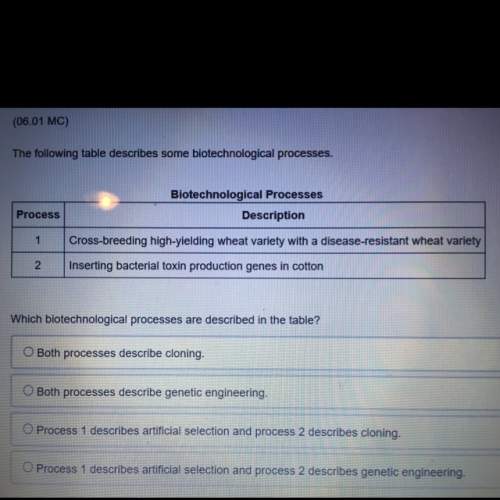
Biology, 08.07.2019 11:00 xgibson123
Amodel organism is a species that researchers study to better understand certain biological processes. mollusks and arthropods are commonly used as model organisms for studying mechanisms of learning and memory, while sponges and jellyfish are not. why is this? a. mollusks and arthropods exhibit cephalization, while jellyfish and sponges do not. b. mollusks and arthropods exhibit segmentation, while jellyfish and sponges do not. c. mollusks and arthropods can detect stimuli from their environment, while jellyfish and sponges cannot. d. mollusks and arthropods can respond to changes in their environment, while jellyfish and sponges cannot.

Answers: 1


Other questions on the subject: Biology

Biology, 21.06.2019 20:00, gracethegreat1
Surrounded by microtubules, located near the nucleus. (don't try to google it) (give answer only if u know)
Answers: 1

Biology, 21.06.2019 20:30, chozz2783
Match the descriptions / definitions with the term they best describe 1. three dimensional relationship of the different polypeptide chains in a multisubunit protein or protein complex 2. common folding pattern in proteins in which a linear sequence of amino acids folds into a right-handed coil stabilized by internal hydrogen-bonding between polypeptide backbone atoms. 3. the amino acid sequence of a protein 4. a region on the surface of a protein that can interact with another molecule through noncovalent bonding. 5. three-dimensional arrangement of alpha-helices and beta-sheets within a single polypeptide, typically stabilized by a variety of noncovalent bonds, including ionic and hydrogen bonds, and nonpolar interactions / hydrophobic force. 6. the chain of repeating carbon and nitrogen atoms, linked by peptide bonds, in a protein. 7. common structural motif in proteins in which different sections of the polypeptide chain run alongside each other and are joined together by hydrogen bonding between atoms of the polypeptide backbone. 8. portion of a polypeptide chain that has a discrete tertiary structure of its own and can often fold independently of the rest of the chain 9. regular local folding patterns in a protein, including alpha-helix and beta-sheet a. primary structure b. beta-sheet c. protein d. coiled-coil e. polypeptide backbone f. secondary structure g. side chain h. tertiary structure i. binding site j. alpha-helix k. quaternary structure l. protein domain
Answers: 2

Biology, 22.06.2019 09:00, nireegnu
The current thought on the structure of the cell membrane is: a. a static phosphate sandwich of lipids b. a fluid-mosaic of phospholipids and proteins c. a bilayer of proteins with static lipid molecules d. an impermeable bilayer of protein molecules e. a static and permeable phospholipid single layer
Answers: 2

Biology, 22.06.2019 13:00, abronxtale02
Grade 91.)the gravitational pull from the moon words).2.) what is the rate of gravitational 3.)if you drop a hammer, is it more likely to drop handle side down, head side down, or equal chance that it will land either way? why? 4.)a car moves 60km east and 90km west. a.) what is the distance the car traveled? b.) what is the car's displacement5.)what is the average velocity of a car that moved 60 km south in 3 hours? 6.) a car starts from rest and acceleration to 60 m/s over a time of 5 seconds. what is the acceleration of the car? 7.)what is the speed of an object at rest?
Answers: 1
You know the right answer?
Amodel organism is a species that researchers study to better understand certain biological processe...
Questions in other subjects:









English, 29.07.2019 11:00

Social Studies, 29.07.2019 11:00




